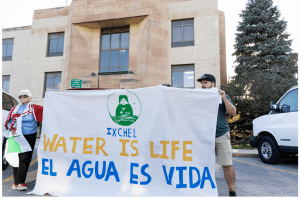Water and Equity in Latinx Communities: Ixchel’s Approach
The communities of Cicero (population 83,000) and Berwyn (population 56,000), two western Chicago suburbs, are majority Latinx – 90% and 63% respectively – and low-income. They are also both the focus of Ixchel, a grassroots organization whose mission is to, “cultivate grassroots leaders to dismantle structural racism for racial equity in education and environmental justice and ensure access to equitable resources.” In particular, Ixchel focuses on community members of Cicero and Berwyn who are low-income people of color, including immigrants.
These communities face a long litany of environmental threats that compromise public health and erode residents’ quality of life. They live with frequent instances of urban flooding, which damage basements and cause sewer backups. They live with releases of hydrogen sulfide and ammonia from the nearby Stickney Plant, the largest wastewater facility in the world. They live with high levels of lead in their drinking water supplies from lead service lines – a recent area of focus for Ixchel.
Delia Barajas, Founding Director of Ixchel and community member, first approached River Network when Ixchel applied to become part of the Safe and Affordable Drinking Water Peer Learning Cohort. With funding from the Kresge Foundation, River Network launched this project to directly support communities working to engage stakeholders and pursue equitable solutions to their local drinking water issues. The cohort was also designed to promote collective learning and the exchange of effective local solutions between members.
As Barajas explains, when she first purchased her Cicero home and was informed it contained lead paint, she wasn’t sure what that meant. It was only years later she learned there is no known safe level of lead in children’s blood and that even low lead levels have been shown to affect children’s IQs, an irreversible impact. While reading the water utility’s annual Consumer Confidence Report (CCR) in the local newsletter, she noticed the Town of Cicero could not guarantee local drinking water was safe. She also noticed Cicero reported no lead in the testing and became suspicious since Cicero and Berwyn are known to be hot spots for lead. Ixchel quickly mobilized, securing a small grant to work with a toxicologist to review old CCRs. There were worrisome discrepancies in the data. Ixchel began filing Freedom of Information Act requests in an effort to pinpoint the location of lead service lines in the community – information the utility said they did not have.
In late 2017, in partnership with Virginia Tech (VT), Ixchel sampled drinking water in 10 Cicero homes. They found at least three homes with lead levels exceeding the EPA’s action level of 15 parts per billion (ppb), and one home that exceeded 50 ppb on the first water draw. In 2018, Ixchel then launched a Citizen Scientist Project to expand sampling in Cicero and began testing homes in Berwyn. This 2018 testing again showed significant levels of lead in the drinking water of several Cicero and Berwyn homes.

Photo by April Alonso, given courtesy of Cicero Independiente.
Ixchel has worked diligently to keep the issue of lead in the forefront through press conferences, writing op-eds, gaining the attention of local media channels, and raising it directly with city leaders, state regulators, and the federal EPA. Barajas explains, “It is extremely difficult to keep [lead] front and center, but we continue to talk about it as a quality of life issue. The majority of nonprofits that work in the community provide direct services – clothing, food, and other needs. The issue of organizing in the sense of creating racial equity is not something community members are used to.”
Nonetheless, Barajas and other Ixchel leaders are making slow but steady progress. They are engaging community members in one-on-one conversations that help keep the focus on the root causes of the issues they face, rather than on quick fixes. They are also developing tools that capture the extent of the community’s environmental justice issues, such as maps that illustrate each of the many sources of pollution that impact the community.
“(Participating in) the Drinking Water Cohort was a tremendous experience for me and was an opportunity to hear about what other communities are facing,” says Barajas. She describes the contrast between her own local utility and that of the City of Newark, another cohort member, “The difference with them is that they are making an attempt to communicate with the community and taking a different approach, going door-to-door to community members. We don’t see that here in Cicero or Berwyn. Recently someone raised the issue of lead before city council and they denied it.”
Though Cicero and Berwyn officials have not, to date, met with community members to discuss Ixchel’s drinking water data, and continue to maintain that the water is “safe to drink,” Ixchel’s tireless efforts are keeping the regulatory wheels turning. Over the past year, Illinois EPA has acted, mandating the Cicero water utility to conduct further testing to investigate lead levels. Additionally, in August of this year, the agency issued the City of Berwyn a Notice of Violation due to its inadequate drinking water reporting, requiring it to submit additional data related to lead levels in homes with lead service lines. These state-level responses underscore the impact of Ixchel’s advocacy and serve as inspiration for other groups faced with setbacks at the local level.
Further reading:
- “Addressing the Lead Burden,” Lawndale News Noticiero Bilingue
- “Cicero and Berwyn Residents Concerned about High Lead Levels in Drinking Water,” Ixchel op-ed in El Cicero Independiente
- “Surging Waters: Science Empowering Communities in the Face of Flooding,” American Geophysical Union






Diana and River Network staff;
Thank you for the tremendous articles you have written about communities of color and drinking water.